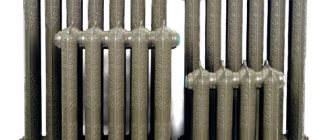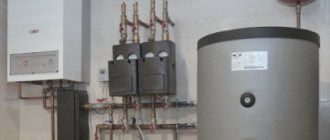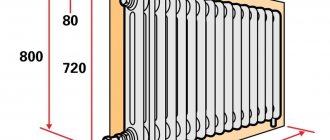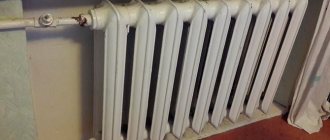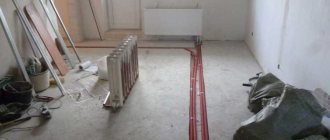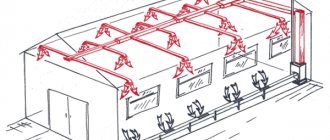External inspection of the heating system
Unfortunately, they make a heating system for the house so that you can live comfortably in the house. The heating of an apartment building “for show” can be determined by a simple inspection. Poor quality heating work can be identified by the following signs:
- Small heating radiators that do not match the size of the windows;
- Panel convectors are installed without a protective casing;
- Radiators are installed crookedly;
- The plastic heating pipeline is embedded in the screed. It is unacceptable.
Advantages of gas boilers for apartments:
- Small-sized, does not require large space for installation in an apartment, and is light in weight;
- Installation of gas equipment is easy using a set of fastening tools;
- They are characterized by sufficient power (10-25 kW) to heat one four-room apartment with an area of up to 100 m2;
- Can be manufactured with either one or two circuits.
You can learn about the advantages and disadvantages of individual heating in general in the following article about heating.
Finding out the heating scheme of the house (apartment)
There are two fundamentally different heating schemes: collector and pipe. Both are easy to identify by visual inspection.
With a manifold heating scheme, a separate pipeline connects to all radiators in the apartment. All heating pipes are brought together into a common distribution unit called a manifold. In large apartments there may be more than one such collector.
This is a very successful heating scheme and if it is done correctly, it adjusts and works perfectly. However, completely redoing such a heating scheme will be much more expensive.
The pipe circuit can be two-pipe or one-pipe. In new apartment buildings, a two-pipe heating system is used. With this scheme, heating radiators are divided into groups, each group has its own heating risers. The risers are clearly visible in the corners of the rooms.
This heating system is dependent, that is, in the absence of bypasses (jumpers) on the radiators, a heating failure in your neighbor will lead to a heating failure in yours. In addition, the quality and cleanliness of each of your radiators will affect the performance of the radiators of its group. Repairing or replacing such a heating system is easier and cheaper. Installing bypasses and high-quality radiators solves all heating problems in a new building.
Choosing pipes
Modern design of heat supply systems is 95% based on the use of plastic, polyethylene, and corrugated stainless steel pipes. Each of them has its own disadvantages and advantages.
Metal and copper pipes also have the right to exist, but due to their tendency to corrosion, high cost, and complexity of installation, their use is declining. Preference is given to plastic products that are not inferior in characteristics. For detailed recommendations on choosing heating pipes, watch the video.
Video:
Metal-plastic, polypropylene pipes
Metal-plastic pipes are widely used when laying water supply, heating, and heated floors. They bend well, are easy to install, can withstand significant temperatures and pressure, and have a budget price.
Metal-plastic consists of heterogeneous layers with different coefficients of thermal expansion. Application experience shows that when using metal-plastic for hot water supply, the layers separate, and the pipe fails after 5-7 years. This type of installation of heating pipes in the floor is not recommended.
Polypropylene pipes
Polypropylene has no layers and easily withstands the service life guaranteed by the manufacturer. The main disadvantage is the need to strictly observe the temperature and heating time with a soldering iron during installation. Polypropylene has low thermal conductivity and cannot be used for heated floors.
Corrugated stainless steel pipe
Corrugated stainless pipe, developed using innovative technologies, is recommended for laying heat supply networks. When using such a product, it is easy to install floor heating in a new building or replace old pipelines.
Corrugated stainless steel pipe
Here are some advantages of its use:
- bends easily;
- provides simple connection of fittings, facilitates and speeds up the installation process;
- the corrugated structure compensates for fluctuations in linear dimensions and hydraulic shocks;
- durability;
- does not corrode, there is no sediment on the walls.
PE-X pipes
PE-X – products made from cross-linked polyethylene. Cross-linking is the process of imparting strength to the connection of polyethylene molecules, obtaining a round-shaped product. The pipes are marked (GOST 52134-2003 for Russian manufacturers) indicating the stitching method:
- PE-Xa,
- PE-Xb,
- PE-Xc.
PE-Xa molecules are cross-linked by peroxides. This is an expensive, time-consuming process. PE-Xb – steam crosslinking. The process is simple, so these are the cheapest products in the PE line. PE-Xc - cross-linking with radioactive isotopes.
Polyethylene allows oxygen to pass through well, which allows bacteria to grow inside the heating elements. To prevent oxygen from passing to the coolant, the product is made multilayer. A layer of EVOH is inserted inside.
Innovative developments have led to the creation of polyethylene that is more resistant to high temperatures - PE-RT. In modern construction, heating pipes in an apartment are laid across the floor using PE-RT.
Important! It is recommended to choose a pipe marked PE-RT/EVOH/PE-RT; it is five-layer and does not allow oxygen molecules to pass through to the coolant.
| Name. | Diameter, mm. | thickness , mm. | Price, rub./meter |
| PE-Xb | 16.0 | 2 | 59 |
| PE-X/EVOH | 16.0 | 2 | 28 |
| Elsen PE-Xa | 25 | 3,5 | 208.6 |
| PexPenta PE-Xc | 16 | 2 | 50 |
| Stainless steel corrugated pipe S9 304 | 15 | 95 | |
| Casing, HDPE corrugated for polyethylene 16 mm | 25 | 12 |
New open plan developments
In apartments with free modern layouts, apartment heating schemes are designed in a horizontal plane using a collector heating scheme.
The developer installs heating risers in specially made shafts. Heating in an open-plan apartment is designed and done individually. As a rule, such heating systems are closed with a screed.
It is important to pay attention to:
- Calculation of the heating system, in particular the diameter of the underwater pipes to the radiators from the collector,
- Selection and calculation of the reservoir,
- Selection of radiators
- The main thing is to choose heating pipes certified for covering with screed. These pipes are not in short supply; they are called cross-linked polyethylene heating pipes.
Heating pipes in the floor or a standard riser system. Comparative analysis.
This article will be useful to those who are planning to buy a new apartment and are faced with a new trend in the heating sector. Very often, in new buildings, they began to move away from traditional risers that supply coolant (hot water) to the radiators, and to use the laying of plastic pipes directly in the floor. This decision frightens many people, since it is not known how durable and practical it is. After all, there is no direct access to the pipes; check their condition and notice the leak in time. An article about the advantages and disadvantages of such a solution. Let me start right away with the fact that abandoning risers and laying pipes to radiators along the floor is absolutely justified and has a number of advantages. There is no need to be afraid of such heating systems. Firstly, this solution allows you to install a heat meter for heating and pay for heating not according to the standard, but according to actual consumption. For example, when the apartment gets hot or when you go somewhere for a couple of weeks, you can turn off the heating and not pay for it. For example, I have had months in the winter when the heating bill for January or December included a hundred rubles. With a conventional heating system using risers, it is technically impossible to install a heat meter. The fact is that in the case of floor distribution, there is only one central riser, which is located in the entrance, and from it the heating radiates throughout the apartments. That is, heating is apartment-by-apartment. A heat meter is installed at the outlet from the riser. In the case when each battery has its own riser, it is impossible to install a heat meter, since there are several risers in the apartment and, more importantly, the coolant flows from floor to floor, which makes it impossible to calculate the amount of coolant spent on heating specific apartment. This leads to another significant advantage of installing heating pipes in the floor - if necessary, you or your neighbors above (below) can turn off the heating of only your apartment in the event of an accident or repair without harming others. While in the standard version you will have to block the entire riser from the first to the last floor. Moreover, in order to shut off the riser, you will have to notify the management company (housing office), while with apartment heating there is no need for this - just go out to the stairwell of your floor and turn off the tap.
Another significant advantage of the system is its maintainability. The service life of heat-resistant plastic pipes is twice as long as that of conventional standard pipes in risers. If a pipe needs to be replaced, the floors will not have to be opened. It is precisely this moment that scares many people away. The stereotype works: if a pipe is in the floor, it means that sooner or later the floor will have to be broken in order to replace the damaged section of the pipe. Not at all. All pipes running in the floor are laid in a special corrugation (SNiP requirement), due to which the replacement of a damaged pipe occurs without opening the floor.
Another advantage of such a heating system is the fact that the pipes running in the floor heat the floor. In addition to hot radiators, we get heated floors. The heating is especially noticeable if floor tiles were used as a floor covering (for example, in the kitchen). The heating of the floor, of course, is uneven - only where the pipes pass. But you won’t have to pay extra for these “warm floors”.
Well, the last, probably the most obvious, advantage is that there are no risers in the apartment that need to be hidden or put up with the fact that they will spoil the appearance of the room. Indeed, in the case of floor distribution of pipes supplying and discharging coolant, we only have in the room the radiator itself, the pipes from which go to the floor.
The only disadvantage of the system is the possibility of its damage during some repair work. It is necessary to drill the floor quite carefully. Of course, when installing flooring, be it laminate, tiles or carpet, this is not required. But there is work related to the installation of sliding wardrobes, installation of door thresholds, when the need nevertheless arises to drill the floor. But, firstly, the pipes lie at a certain depth (at least 4-5 cm), and secondly, you can ask the management company to give you a diagram of the pipes in the floor so that you know where exactly these pipes go (such diagrams should be there) . And thirdly, in the worst case scenario, if you do damage the pipe, it can be replaced without opening the floor.
Also, many are afraid that a pipe laid under the floor may spontaneously leak. This is practically impossible, since before pouring the floor, water is supplied to the pipes under a pressure of 12 atmospheres (working pressure during the heating season does not exceed 6 atmospheres). And only after checking the pipes for leaks, workers begin pouring the floor. Another thing is how well the organization followed the work technology. In any case, the organization that carried out the work is responsible and will carry out repairs, if anything, at its own expense.
In my opinion, the advantages of a floor-to-room heating system still significantly outweigh the single disadvantage that I described just above. But the final choice is yours. I hope you found the article useful. When copying an article or parts thereof, a link to the source and author is required.
10
+ Thank you
Comment

